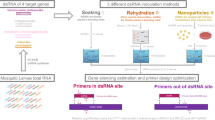Abstract
We conducted the world’s first experiments under semi-field conditions (ACL-2 field house) to assess the mating competitiveness of genetically sterile RIDL male mosquitoes (513A strain). The field house is a state-of-the-art, fully-contained trial facility, simulating the living space for a household of 2–4 people in Peninsular Malaysia. Ten genetically sterile RIDL male A. aegypti mosquitoes competed with ten wild type males inside this field house to mate with ten wild type females. Hatched larvae from mated females were screened under a fluorescent microscope for genetic markers to determine if they were fathered by RIDL male or wild type male, and all results were cross-checked by PCR. Two such experiments were conducted, each repeated sufficient number of times. All strains were on a Malaysian lab strain background for the first experiment, while the RIDL males alone were on a recently-colonised Mexican strain background for the second experiment. A total of 52 % of the matings were with RIDL males in the first experiment, while 45 % of the matings were with RIDL (Mexican) males in the second experiment. Statistically, this is not significantly different from 50 % of the matings expected to take place with RIDL males if the latter were as competitive as that of the wild type males. This shows that A. aegypti RIDL-513A has excellent mating competitiveness under semi-field conditions, verifying earlier trends obtained in small lab cages. We also observed high mating compatibility between recently-colonised Mexican RIDL males and lab-reared Malaysian wild type females.



Similar content being viewed by others
References
Alphey L, Nimmo D, O’Connell S, Alphey N (2007) Insect population suppression using engineered insects. In: Aksoy S (ed) Transgenesis and the management of vector-borne disease. Landes Bioscience, Austin, pp 93–103
Benedict M, Robinson A (2003) The first releases of transgenic mosquitoes: an argument for the sterile insect technique. Trends Parasitol 19:349–355
Catteruccia F, Godfray H, Crisanti A (2003) Impact of genetic manipulation on the fitness of Anopheles stephensi mosquitoes. Science 299:1225–1227
Dyck VA, Hendrichs J, Robinson AS (eds) (2005) Sterile insect technique: principles and practice in area-wide integrated pest management. Springer, The Netherlands
FAO/IAEA/USDA (2003) Manual for product quality control and shipping procedures for sterile mass-reared tephritid fruit flies v5.0
Getis A, Morrison AC, Gray K, Scott TW (2003) Characteristics of the spatial pattern of the dengue vector, Aedes aegypti, in Iquitos, Peru. Am J Trop Med Hyg 69(5):494–505
Harmis LD (1983) Increased adult size correlated with parity in Aedes triseriatus. Mosq News 43:77
Irvin N, Hoddle M, O’Brochta D, Carey B, Atkinson P (2004) Assessing fitness costs for transgenic Aedes aegypti expressing the GFP marker and transposase genes. Proc Natl Acad Sci USA 101:891–896
Marrelli MT, Moreira CK, Kelly D, Alphey L, Jacobs-Lorena M (2006) Mosquito transgenesis: what is the fitness cost? Trends Parasitol 22:197–202
McCombs SD (1980) Effect of different nutrition of larvae on adult fitness of Aedes triseriatus, Masters Thesis, University of Notre Dame
Phuc HK, Andreasen MH, Burton RS, Vass C, Epton MJ, Pape G, Fu G, Condon KC, Scaife S, Donnelly CA, Coleman PG, White-Cooper H, Alphey L (2007) Late-acting dominant lethal genetic systems and mosquito control. BMC Biol 5:11
Scott TW, et al (2006) Fitness studies: developing a consensus methodology. In: Knols BGJ, Louis C (eds) Bridging laboratory and field research for genetic control of disease vectors. Springer ISBN: 1-4020-3800-3
Thomas DD, Donnelly CA, Wood RJ, Alphey LS (2000) Insect population control using a dominant, repressible, lethal genetic system. Science 287:2474–2476
Vythilingam I, Chiang GL, Lee HL, Singh K (1992) Bionomics of important mosquito vectors in Malaysia. Southeast Asian J Trop Med Pub Hlth 23:587–603
Acknowledgments
We thank the Director-General of Health, Malaysia for permission to publish. One of us (SV) thanks the Akademi Sains Malaysia for an Associateship. We acknowledge all staff members of the Unit of Medical Entomology, IMR-Oxitec Collaborative Project, IMR and CEBAR-University of Malaya for their support. This project was supported by a research grant (06-053) from the National Institutes of Health, Malaysia.
Author information
Authors and Affiliations
Corresponding author
Rights and permissions
About this article
Cite this article
Lee, H.L., Vasan, S., Ahmad, N.W. et al. Mating compatibility and competitiveness of transgenic and wild type Aedes aegypti (L.) under contained semi-field conditions. Transgenic Res 22, 47–57 (2013). https://doi.org/10.1007/s11248-012-9625-z
Received:
Accepted:
Published:
Issue Date:
DOI: https://doi.org/10.1007/s11248-012-9625-z




